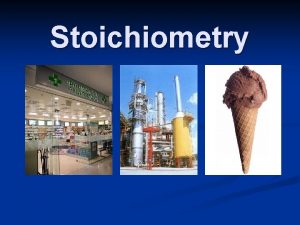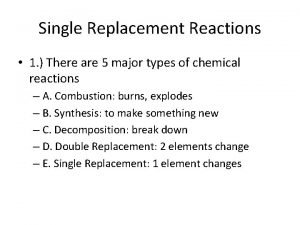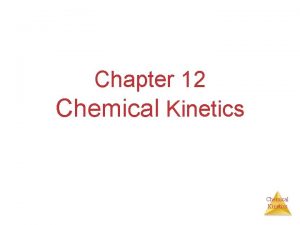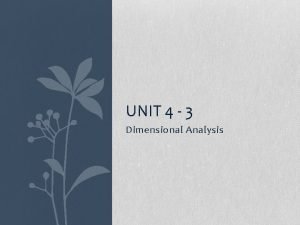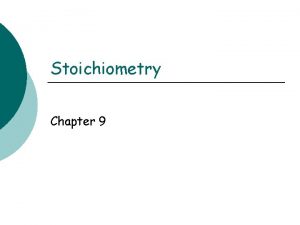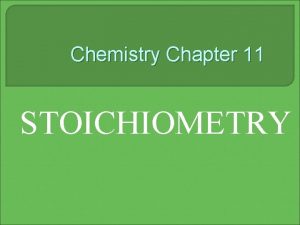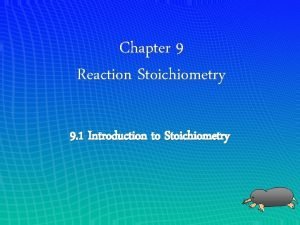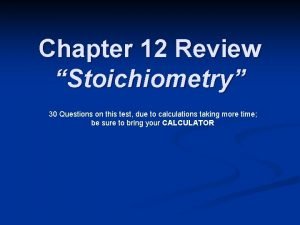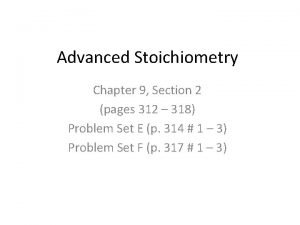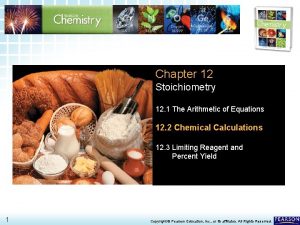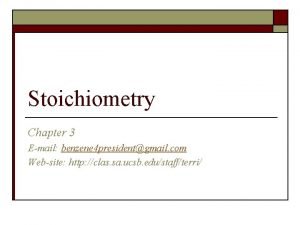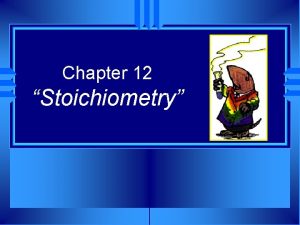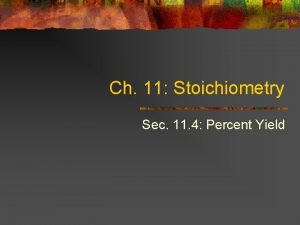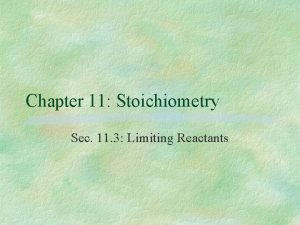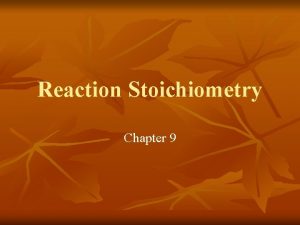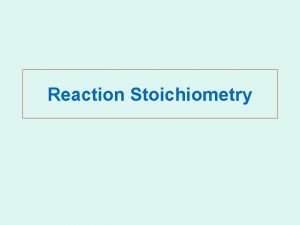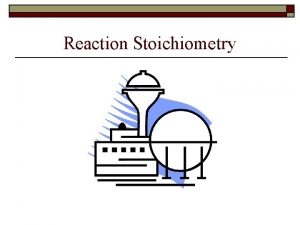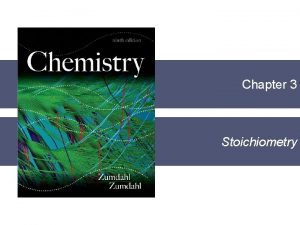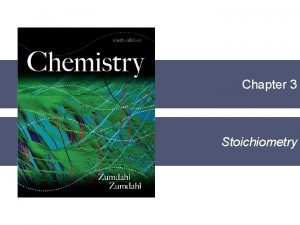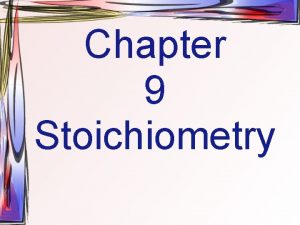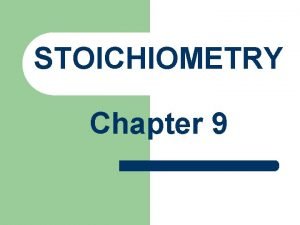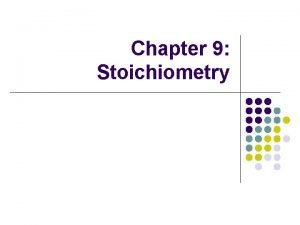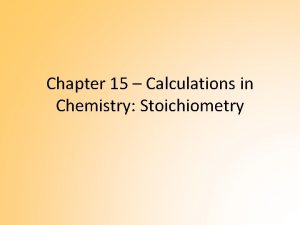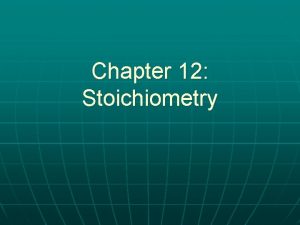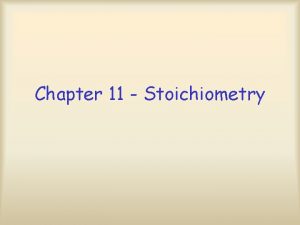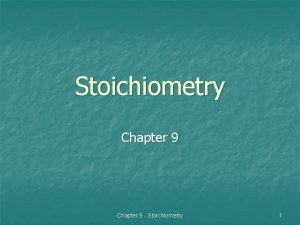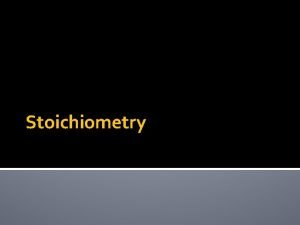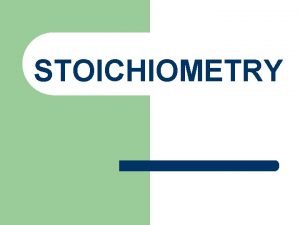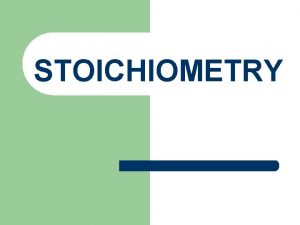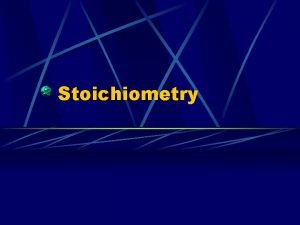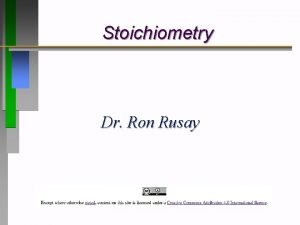Reaction Stoichiometry Unit 9 Chapter 9 Reaction Stoichiometry






















- Slides: 22

Reaction Stoichiometry Unit 9 Chapter 9

Reaction Stoichiometry n Reaction stoichiometry – calculating the amount of one substance from another in a reaction

Review significance of a balanced eqn: 2 Mg + O 2 2 Mg. O 2 atoms Mg + 1 O 2 molec 2 formula n units Mg. O 2 mol Mg + 1 mol O 2 2 mol Mg. O

We will consider the coefficients in the reaction to be moles.

n Mole ratios: a ratio that relates two different substances to each other based on the balanced rxn. n Ex: 2 mol Mg. O 1 mol O 2 2 mol Mg. O

Stoichiometric Calculations Steps to Solving Stoichiometry Problems: 1. Balance Eqn. & write given and unknown under eqn. 2. Convert given to moles of same substance 3. Mole Ratio: mol unknown/ mol known 4. Covert to unit needed.

Mass – Mass Calculations In a lab, solid substances are usually measured out in grams. 1. How many grams of Sn. F 2, used in toothpaste, are produced from the reaction of 30 g of HF with Sn? Prac p 287 and section review p 287

Cu + Ag. NO 3 Cu(NO 3)2 + Ag 2. a. b. How many grams of silver will be produced if 125 g of copper is reacted with silver nitrate. How many grams of copper is needed to complete the rxn if 200 g of silver nitrate is used?

3. A camping lantern uses the reaction of calcium carbide, Ca. C 2 (s), and water to produce acetylene gas, C 2 H 2(g), and calcium hydroxide, solid. How many grams of water are required to produce 1. 55 moles of acetylene gas?

Limiting reactant Excess reactant

2 cookies + 1 marshmallow + 2 kisses 1 smore

Limiting Reactants n n Limiting reactant – reactant that runs out first and limits the amount of product produced. Excess reactant – the substance that is not used up in a rxn.

Strategy 1. Take each reactant amount and calculate the amount of one product it will make. The reactant that makes the smallest amount of product is the limiting reactant. The other is the excess reactant. 2. Calculate amount of excess reactant needed based on the limiting reactant quantity. 3. Determine amounts of products based on limiting reactant amt.

1. If 1. 21 moles of solid zinc are added to 2. 65 moles of hydrochloric acid, HCl, then zinc chloride, Zn. Cl 2 (aq), and hydrogen gas are formed. Determine which reactant is in excess and by what amount and calculate the number of moles of each product.

2. Given the following rxn: 3 Fe + 4 H 2 O Fe 3 O 4 + 4 H 2 a. When 36 g of water is mixed with 167 g of Fe, which is the limiting reactant? b. What mass in grams of iron (IV) oxide is produced? c. How much of the excess reactant remains after the rxn stops.

d. Calculate the percent yield if 100. 5 grams of iron (IV) oxide is obtained.

Percent Yield n Percent yield = actual yield * 100 theoretical yield Actual yield = amt of product obtain from experiment Theoretical yield = maximum amt of product can be produced according to calculations.

Given the following equation: C 6 H 6 + Cl 2 C 6 H 5 Cl + HCl When 36. 8 g of C 6 H 6 react with an excess of chlorine, the actual yield of C 6 H 5 Cl is 38. 8 g. What is the percent yield of C 6 H 5 Cl ? 1.

n Read sample prob 9 -8 p 293, then set up bal eqn and the given info and the unknown: C 6 H 6 + Cl 2 C 6 H 5 Cl + HCl 38. 8 g excess 38. 8 g actual 38. 8 g ? g theoretical A x 100 % yield of C 6 H 5 Cl T Prac p 294 and section review p 294

The reaction between phosphorus and oxygen produced solid tetraphosphorus decoxide. A. Determine the mass of tetraphosphorus formed if 25. 0 grams of phosphorus(P 4) and 50. 0 grams of oxygen are combined.

B. How much excess reactant remains after the reaction stops? C. If 50. 0 grams of P 4 O 10 is actually obtained, what is the percent yield?

Hydrate A cmpd with water bonded to it. Notation: Cu. SO 4 · 5 H 2 O(s) The molar mass is _______.
 Reaction order
Reaction order Chapter 11 assessment chemistry
Chapter 11 assessment chemistry Stoichiometry refers to
Stoichiometry refers to Stoichiometry definition
Stoichiometry definition Single replacement formula
Single replacement formula Reaction rate and stoichiometry
Reaction rate and stoichiometry Unit 6 review questions
Unit 6 review questions Unit: stoichiometry “multi-step problems” – ws #3
Unit: stoichiometry “multi-step problems” – ws #3 Chemistry chapter 9 stoichiometry
Chemistry chapter 9 stoichiometry Modern chemistry chapter 9 stoichiometry test b answers
Modern chemistry chapter 9 stoichiometry test b answers Chemical equation defintion
Chemical equation defintion Stoichiometry chapter 9 test
Stoichiometry chapter 9 test Chapter 9 review stoichiometry section 1
Chapter 9 review stoichiometry section 1 The first step in most stoichiometry problems is to ____.
The first step in most stoichiometry problems is to ____. Chapter 9 review stoichiometry section 2
Chapter 9 review stoichiometry section 2 Chapter 12 stoichiometry answer key pearson
Chapter 12 stoichiometry answer key pearson Chapter 9 section 3 stoichiometry
Chapter 9 section 3 stoichiometry Chapter 3 stoichiometry answer key
Chapter 3 stoichiometry answer key Chapter 12 stoichiometry
Chapter 12 stoichiometry Chapter 11 stoichiometry answer key
Chapter 11 stoichiometry answer key 11-3 practice problems
11-3 practice problems Addition reaction and substitution reaction
Addition reaction and substitution reaction Leukoerythroblastic reaction vs leukemoid reaction
Leukoerythroblastic reaction vs leukemoid reaction



